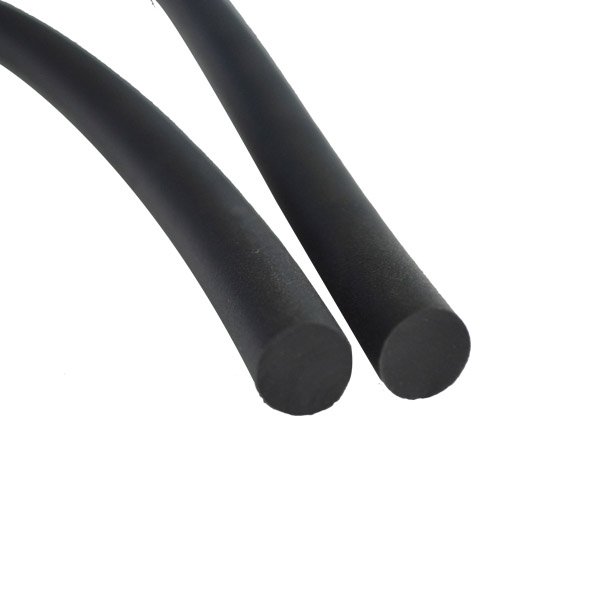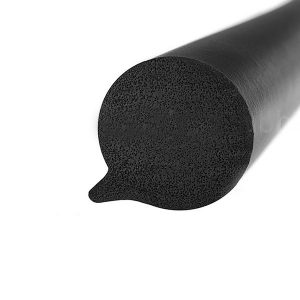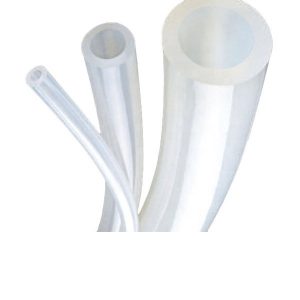Sealing, cushioning, and vibration dampening are essential for mechanical and civil engineering projects. Various industries created different types of seal strips to meet these device requirements. Due to technological advancement, people made more efficient machines and buildings. Various rubber products typically increase the total efficiency of these places of application. In this case, rubber cord is an important material used in many industries.
Rubber cords are popular due to their flexibility, durability, and resistance to abrasion and chemicals. It is popular in the automotive, aerospace, construction, marine, electrical, and medical industries. However, keeping that importance in mind, we have created this article. This article will be helpful content for those who want to know more about the functions and types of rubber cords.
This article aims to provide a definitive guide to rubber cords. It covers types, materials, applications, manufacturing processes, pros and cons, and more. This article will be a comprehensive resource for those working with rubber cords. In addition, it will also help the interested person to learn more about cord rubber properties and applications. However, at the end of this article, you will better understand the fundamentals of rubber cords.
What is A Rubber Cord? How Does it Work?
A rubber cord is a flexible material made from different rubber materials. It is typically prevalent in sealing, cushioning, and vibration damping. Rubber cords can be stretched and compressed without breaking. They come in different shapes, including solid, hollow, and co-extruded. In the later part of this article, we will discuss these shapes elaborately.
The physical properties of cord rubber provide reliable and long-lasting performance. When a cord rubber is compressed or stretched, it absorbs the force and resists deformation. As a result, the elastic nature of the rubber returns to its original shape and size when pressure is released. This process results in improved cushioning and vibration-dampening properties.
Rubber cord works as a barrier against different external factors. These factors may include dust, moisture, and forces that can cause damage or impact performance. It also works against vibration and reduces noise. As a result, you will see the application of this product in many industries. The popular sectors are automotive, aerospace, construction, marine, electrical and medical. The manufacturing process for rubber cords typically involves several steps. It includes preparation of the raw materials, extrusion of the cord rubber, vulcanization, and finishing.
Mixing -> Extrusion -> Vulcanization -> Cutting, and packaging
Cord rubber is vital in temperature, chemical, abrasion, and compression set resistances. These specific properties of rubber can affect its performance in different applications. Therefore, choosing the right type of cord rubber is essential.
Rubber Cord Applications
Rubber cords provide excellent flexibility, durability, and resistance to abrasion and chemicals. As a result, they are popular in many applications in various industries. Here are some of the most common applications of rubber cords:
- Sealing: Rubber cords are often prevalent in sealing automotive, aerospace, and industrial devices. They close the gaps between two parts and prevent water, dust, and other contaminants from entering.
- Cushioning: Rubber cord is also prevalent as a cushioning material to absorb impacts. It reduces vibration in industrial machinery and equipment. It is also popular in the construction, marine, and electrical industries. Moreover, it protects sensitive equipment from shock and vibration.
- Electrical Insulation: The cord rubber is excellent with good electrical insulation properties. It is prevalent in electrical applications to insulate wires and cables. Cord rubber is used in high-voltage applications to protect workers from electrical shock.
- Medical Applications: We often see rubber cords in various medical devices. Surgical equipment and prosthetics are the most common among them. They are used as cushioning materials to provide comfort and support.
- Automotive Applications: Rubber cords are also prevalent in various automotive applications. Engine mounts, fuel tanks, and door seals are the most common examples of rubber cord applications.
- Aerospace Applications: Aircraft windows, door seals, and fuel tanks require high-quality rubber cords.
- Sporting Goods: Rubber cords are also prevalent in sporting goods such as tennis rackets and gym equipment. They absorb shock to reduce the impact of ball and racket collisions.
Types of Rubber Cord
A rubber cord may come in various types. Each of these types is designed to suit different applications and requirements. Rubber cords come in various shapes and sizes to suit multiple applications. Here are some of the most common types of rubber cords:
- Solid rubber cord: These rubber cords are made from solid rubber and are available in various shapes and sizes. The solid cord is popular in sealing applications. It is prevalent in applications requiring flexible material to prevent water, dust, or air from entering. Automotive, aerospace, and construction are some of the most popular sectors of applications.
- Sponge rubber cord: These rubber cords are made from sponge rubber, which is popular in cushioning applications. Since they are compressible, they can absorb impacts. As a result, it can reduce vibration in industrial machinery and equipment. Sponge rubber cords are popular in the HVAC, electrical, and automotive sectors.
- Hollow rubber cord: These rubber cords usually have an open center from extruded rubber. They are also prevalent in sealing and cushioning applications. These rubber cords are often used as door seals and window seals.
- Co-extruded rubber cord: These rubber cords are made from multiple layers of rubber materials. They are incredibly beneficial for applications where flexibility and hardness are the concerns. However, co-extruded rubber cords are often prevalent in automotive and aerospace applications.
Rubber Cord Materials
Rubber cords come from various types of rubber materials. Each type of material provides unique properties and capabilities. Here are some of the most popular rubber materials:
A. Natural Rubber
Natural rubber usually comes from the sap of the Hevea brasiliensis tree. It is a highly versatile polymer. It has excellent strength, flexibility, and elongation properties. As a result, it has become ideal for many applications. The most famous natural rubber cord application sectors are automotive, construction, and marine.
B. Synthetic Rubber
This type of cord rubber comes from an artificial compound. It mimics the properties of natural rubber. Synthetic rubber offers enhanced durability and resistance to harsh environmental conditions. However, some most popular synthetic rubber cords are:
- Silicone Rubber: These rubber cords are famous for high-temperature and chemical resistance. It is often found in medical, food processing, and automotive applications.
- EPDM Rubber: These rubber cords resist weathering, UV radiation, and ozone. As a result, these rubber cords are extremely popular in HVAC applications. HVAC may include automotive, construction, and marine sectors.
- Neoprene rubber: These rubber cords offer excellent oil and chemical resistance properties. In addition, it is also prevalent in weathering and ozone resistance. However, it is often commonplace in marine, construction, and electrical applications.
- Other artificial rubber cords: Many synthetic rubbers are available in the market. Some types are nitrile rubber, viton rubber, styrene-butadiene rubber, and butyl rubber. These materials are prevalent in various industries, such as automotive, aerospace, and construction.
C. Thermoplastic Rubber
TPR, or thermoplastic rubber, is another type of rubber that combines the properties of rubber and plastic. TPR cords offer excellent durability, flexibility, and resistance to harsh environments. However, they are trendy in consumer products. Some of the most popular products are toys, sporting goods, and industrial and automotive applications.
Choosing The Right Rubber Cord For Your Application

Selecting a suitable cord is essential to ensure optimal performance and longevity. Here are some of the most important factors to consider while choosing an appropriate rubber cord:
- Temperature Resistance: This factor determines the rubber cord’s ability to withstand extreme temperatures. In this case, the right cord will maintain its properties and performance at the temperature range of the application.
- Chemical Resistance: This factor determines the ability to withstand exposure to different chemicals. The selected cord rubber must be compatible with the chemicals it will contact. It prevents the chemical degradation and failure of the rubber cords.
- Abrasion Resistance: This factor determines the ability to withstand exposure to abrasive environments. In this case, selecting the ideal rubber cords will prevent damage and premature failure.
- Compression set resistance is the permanent deformation of rubber cords when compressed. This factor is critical to consider while selecting the appropriate cord rubber. It involves prolonged compression and determines the cord’s ability to retain its original shape.
- UV resistance: When selecting the best rubber cord for your application, it is also essential to consider. It determines the ability of rubber cords to withstand exposure to sunlight. It is important to note that high UV radiation may degrade and create cracks in rubber products.
Conclusion
In conclusion, a rubber cord is a versatile and essential component used in various industries. Automotive, construction, and aerospace are popular rubber cord implementation sectors. The types of rubber cords typically vary based on structure, materials, and application. As a result, it is crucial to understand cord rubber types and their properties to select the right choice for your application.
Seashore Rubber is a famous manufacturer of different rubber products. However, cord rubber is one of the primary products of this factory. They offer different types and materials of rubber cords. In this case, you have many options to select the right choice for your project. Above all, if you have any questions regarding their products and services, contact them immediately.



